Roman - Others - Fotogalerie - Sold antiquities
Archive of sold antiquities
All artefacts sold in our gallery are fully documented in our online archive and database. Being a specialist ancient art dealer, preserving also the more recent history of each and every piece sold in our shop is at our heart. That is particularly useful for artefacts that changed owners in the meantime. Information that may have been lost in the process can be easily restored from our archives. Please do not hesitate to contact us if you need further information about ancient items that have been sold in our gallery. We can help you with reconstructing the history of ownership for those items. All information about our customers will be kept confidential, of course.-
 Roman Celtic seal box
Roman Celtic seal boxLozenge shaped body with lid in Celtic design. A piece from the 1st or 2nd century, found near the Celtic settlement and later Roman town of Lindum. Published in a standard work by Richard Hattatt.
Price: on request Roman seal box
Roman seal boxPiriform body with engraved cross on the lid. A piece from the Roman Imperial period. Published in a standard work by Richard Hattatt.
Price: on request Roman seal box
Roman seal boxPiriform body with engraved bird on the lid. A piece from the Roman Imperial period, found near Dover. Published in a standard work by Richard Hattatt.
Price: on request Roman seal box with phallus
Roman seal box with phallusCircular body with protective phallus in high relief on the lid. A piece from the Roman Imperial period, found in North East England. Published in a standard work by Richard Hattatt.
Price: on request Base plate of a Roman mirror
Base plate of a Roman mirrorThe bronze disc is the base plate of a Roman mirror. A handle and reflective metal coating were once part of the mirror. Typical for upper class Roman households during Imperial times.
Price: on request Late Roman votive mirror
Late Roman votive mirrorExceedingly rare in this state of preservation, including remains of the original glass and reflective lead foil.
Price: on request Roman mirror from Baalbek
Roman mirror from BaalbekThe bronze disc is the base plate of a bronze mirror, that was once attached to a handle and coated with a reflective metal layer. Typical for upper class Roman households during Imperial times.
Price: on request Roman mirror from Baalbek
Roman mirror from BaalbekThe bronze disc is the base plate of a bronze mirror, that was once attached to a handle and coated with a reflective metal layer. Typical for upper class Roman households during Imperial times.
Price: on request Roman military whistle
Roman military whistleHistorically interesting example of Roman military equipment. Whistles of this type have been used in the 1st to 2nd cent. AD. Their function is not fully understood, yet.
Price: on request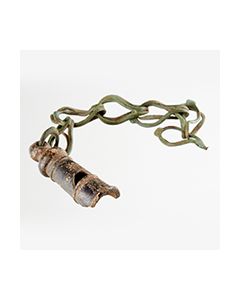 Roman military whistle
Roman military whistleHistorically interesting example of Roman military equipment. Whistles of this type have been used in the 1st to 2nd cent. AD. Their function is not fully understood, yet.
Price: on request römische Beschläge aus Bronze
römische Beschläge aus BronzeLot aus 5 Kleinbronzen, perfekt erhalten mit schöner Patina. Aus alter deutscher Sammlung.
Price: on request Gruppe 5 antiker Gürtelschnallen
Gruppe 5 antiker GürtelschnallenRömische Gürtelschnallen aus Bronze. Etwa 1. bis 6. Jh. n. Chr., diverse Ausführungen. Pannonische Provinzen.
Price: on request Römischer Würfel aus Bein
Römischer Würfel aus BeinGroßer römischer Würfel aus Bein, 1. Jhd.n.Chr. Mit attraktiver, dunkler Tönung.
Price: on request Römischer Würfel aus Bein
Römischer Würfel aus BeinGroßer römischer Würfel aus Bein, 1. Jhd.n.Chr. Mit attraktiver, dunkler Tönung.
Price: on request Römischer Würfel aus Bein
Römischer Würfel aus BeinGroßer römischer Würfel aus Bein, 1. Jhd.n.Chr. Mit attraktiver, dunkler Tönung.
Price: on request Römisches Tonsieb
Römisches TonsiebRotes Terracotta, außen verziert durch Zierrillen, breiter Henkel.
Price: on request Mühlespielbrett aus einer Hypokaustanlage mit Stempel
Mühlespielbrett aus einer Hypokaustanlage mit StempelDas Stück stellt ein Unikat dar. Die Stempellesung ist unbekannt, ebenso wie Vergleichsstücke in der Forschungsliteratur.
Price: on request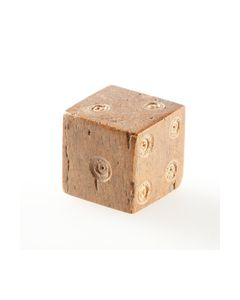 Römischer Würfel aus Bein
Römischer Würfel aus BeinGroßer römischer Würfel aus Bein, 1. Jhd.n.Chr. Mit attraktiver, dunkler Tönung.
Price: on request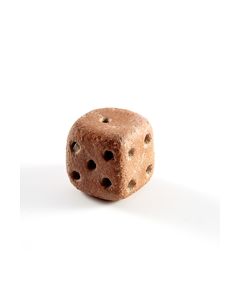 Römischer Würfel aus Stein
Römischer Würfel aus SteinCa. 1. bis 4. Jh. n. Chr., Summen der Gegenüberseiten 4, 6, 11.Ca. 16mm Kantenlänge.
Price: on request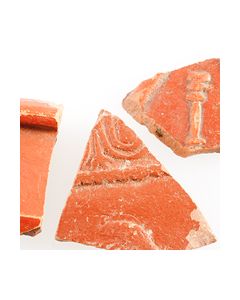 Gruppe von 3 Terra Sigillata-Fragmenten
Gruppe von 3 Terra Sigillata-FragmentenRömisch, 1. bis 3. Jh. n.Chr., Provinzen Germania, Scherben von Keramik mit rotem Glanzton-Überzug (Engobe). Bemerkenswert sind die erhaltenen Dekorationselemente.
Price: on request Römischer Würfel aus Bein
Römischer Würfel aus BeinGroßer römischer Würfel aus Bein, 1. Jhd.n.Chr. Mit attraktiver, dunkler Tönung.
Price: on request Römischer Würfel aus Bein
Römischer Würfel aus BeinGroßer römischer Würfel aus Bein, 1. Jhd.n.Chr. Mit attraktiver, dunkler Tönung.
Price: on request Römischer Löffel aus Bronze
Römischer Löffel aus BronzeLöffel vollständig erhalten, schöne Patina. Römische Kaiserzeit - Spätantike. Länge: 47 mm.
Price: on request Römischer Würfel aus Bein
Römischer Würfel aus BeinGroßer römischer Würfel aus Bein, 1. Jhd.n.Chr. Mit attraktiver, dunkler Tönung.
Price: on request Römischer Würfel aus Bein
Römischer Würfel aus BeinGroßer römischer Würfel aus Bein, 1. Jhd.n.Chr. Mit attraktiver, dunkler Tönung.
Price: on request Großer römischer Würfel aus Bein
Großer römischer Würfel aus BeinGroßer römischer Würfel aus Bein, 1. Jhd.n.Chr. Mit attraktiver, dunkler Tönung.
Price: on request Römischer Fingerhut
Römischer FingerhutKörper an Öffnung zusammengedrückt, einige kleine Löcher im Metall, ansonsten guter Erhaltungszustand.
Price: on request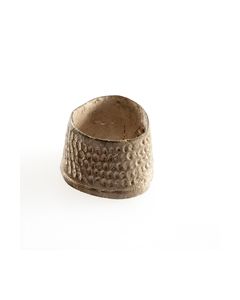 Römischer Fingerhut mit offener Kuppe
Römischer Fingerhut mit offener Kuppemuseale Erhaltung, konische Form, Oberfläche durch punktförmige Eintiefungen gestaltet.
Price: on request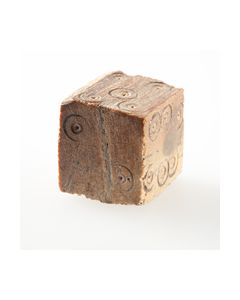 Römischer Würfel aus Bein
Römischer Würfel aus BeinGroßer römischer Würfel aus Bein, 1. Jhd.n.Chr. Mit attraktiver, dunkler Tönung.
Price: on request Römischer Würfel aus Bein
Römischer Würfel aus BeinGroßer römischer Würfel aus Bein, 1. Jhd.n.Chr. Mit attraktiver, dunkler Tönung.
Price: on request Große römische Bronzeglocke
Große römische BronzeglockeMuseumsstück. Massiv, schöne grüne Patina. Römische Kaiserzeit, 1. - 2. Jh. n. Chr. Höhe 58 mm, Durchmesser 63 mm.
Price: on request Römischer Würfel aus Bein
Römischer Würfel aus BeinGroßer römischer Würfel aus Bein, 1. Jhd.n.Chr. Mit attraktiver, dunkler Tönung.
Price: on request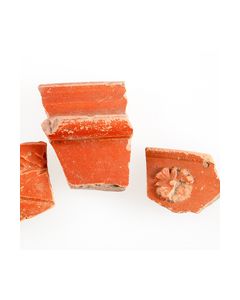 Gruppe von 3 Terra Sigillata-Fragmenten
Gruppe von 3 Terra Sigillata-FragmentenRömisch, 1. bis 3. Jh. n.Chr., Provinzen Germania, Scherben von Keramik mit rotem Glanzton-Überzug (Engobe). Bemerkenswert sind die erhaltenen Dekorationselemente.
Price: on request
 Gruppe von 3 Terra Sigillata-Fragmenten
Gruppe von 3 Terra Sigillata-FragmentenRömisch, 1. bis 3. Jh. n.Chr., Provinzen Germania, Scherben von Keramik mit rotem Glanzton-Überzug (Engobe). Bemerkenswert sind die erhaltenen Dekorationselemente.
Price: on request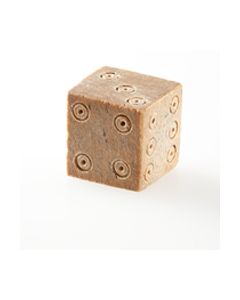 Römischer Würfel aus Bein
Römischer Würfel aus BeinGroßer römischer Würfel aus Bein, 1. Jhd.n.Chr. Mit attraktiver, dunkler Tönung.
Price: on request

